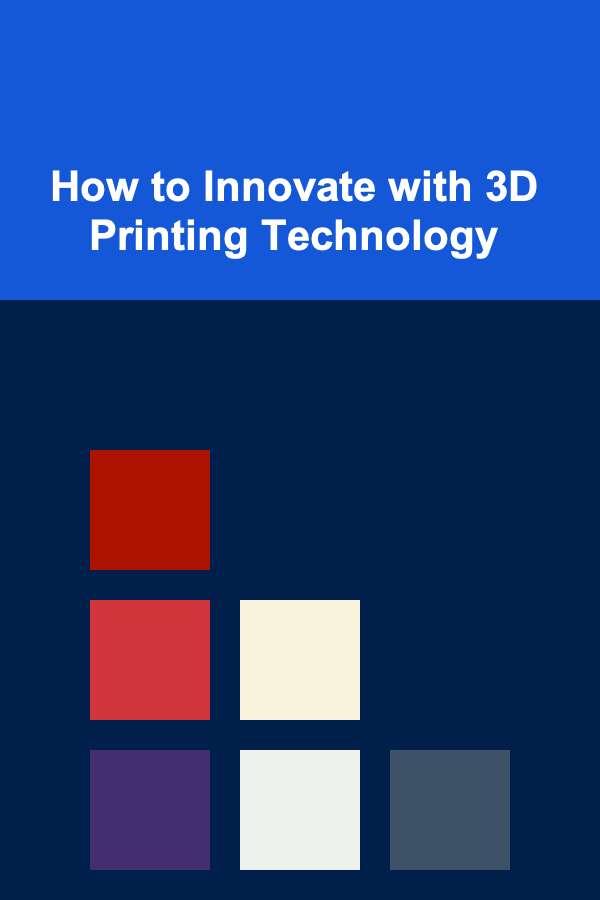
How to Innovate with 3D Printing Technology
ebook include PDF & Audio bundle (Micro Guide)
$12.99$7.99
Limited Time Offer! Order within the next:

3D printing, also known as additive manufacturing, has transcended its initial status as a rapid prototyping tool and evolved into a powerful force driving innovation across diverse industries. Its ability to create complex geometries, customize products, and accelerate production cycles has unlocked unprecedented opportunities for businesses, researchers, and entrepreneurs. However, simply possessing a 3D printer isn't enough; true innovation requires a strategic approach, a deep understanding of the technology's capabilities and limitations, and a willingness to explore uncharted territories. This article delves into the multifaceted ways to innovate with 3D printing technology, exploring its potential impact on various sectors and providing a roadmap for leveraging its disruptive power.
Understanding the Fundamentals of 3D Printing
Before embarking on an innovation journey with 3D printing, it's crucial to grasp its fundamental principles and the different technologies involved. At its core, 3D printing is an additive process where a three-dimensional object is constructed layer by layer from a digital design. This contrasts with traditional subtractive manufacturing methods like machining, where material is removed to create the desired shape.
Several 3D printing technologies exist, each with its own strengths and weaknesses in terms of materials, precision, speed, and cost. Some of the most common methods include:
- Fused Deposition Modeling (FDM): The most widely adopted method, FDM involves extruding a thermoplastic filament through a heated nozzle and depositing it layer by layer onto a build platform. FDM is cost-effective and suitable for prototyping and producing functional parts with moderate complexity. Materials like PLA, ABS, PETG, and nylon are commonly used.
- Stereolithography (SLA): SLA uses a UV laser to cure liquid resin layer by layer. This process offers high precision and smooth surface finishes, making it ideal for intricate designs and models with fine details. SLA resins are typically used, with a growing range of specialized materials available.
- Selective Laser Sintering (SLS): SLS uses a laser to fuse powdered materials, such as nylon, ceramics, or metals, layer by layer. SLS can create strong and durable parts without the need for support structures, allowing for more complex geometries and intricate internal features.
- Selective Laser Melting (SLM) / Direct Metal Laser Sintering (DMLS): Similar to SLS, but using metal powders that are fully melted, SLM/DMLS produces fully dense metal parts with high strength and performance. This technology is used in aerospace, medical, and automotive industries for producing functional components.
- Binder Jetting: This method uses a liquid binder to selectively bind powder materials together, layer by layer. Binder jetting can be used with a wide range of materials, including metals, ceramics, and sand. After printing, parts usually require post-processing, such as infiltration or sintering, to improve their strength and density.
- Material Jetting: Material jetting involves depositing droplets of photopolymers or other materials onto a build platform and curing them with UV light. This technology allows for multi-material printing and can create parts with varying colors and textures.
Understanding the characteristics of each technology is crucial for selecting the appropriate method for a specific application and maximizing its potential for innovation.
Identifying Innovation Opportunities: A Sector-by-Sector Approach
The application of 3D printing is rapidly expanding across various sectors, each presenting unique opportunities for innovation. Here's a glimpse into how different industries are leveraging 3D printing to disrupt traditional processes and create new possibilities:
Healthcare
- Personalized Medicine: 3D printing enables the creation of customized implants, prosthetics, and orthotics tailored to individual patient needs. This can significantly improve patient outcomes and quality of life. For example, custom-fit titanium implants can be designed and printed for complex bone reconstructions, ensuring optimal fit and integration.
- Surgical Planning and Training: 3D-printed anatomical models provide surgeons with a realistic and tangible representation of a patient's anatomy, allowing for better surgical planning and risk assessment. These models can also be used for training purposes, allowing surgeons to practice complex procedures in a safe and controlled environment.
- Pharmaceuticals: 3D printing can be used to create personalized drug dosages and formulations, enabling more precise and effective treatment. "Printlets," for example, can be designed to release drugs at specific rates, optimizing drug delivery and minimizing side effects.
- Bioprinting: An emerging field that uses 3D printing techniques to create functional tissues and organs. While still in its early stages, bioprinting holds immense potential for regenerative medicine, drug testing, and ultimately, organ transplantation. Researchers are actively working on printing skin, cartilage, and even vascularized organs.
Aerospace
- Lightweighting: 3D printing allows for the creation of complex, lightweight components with optimized geometries, reducing aircraft weight and improving fuel efficiency. This is particularly important in the aerospace industry, where even small weight reductions can have significant cost savings.
- On-Demand Manufacturing: 3D printing enables the production of spare parts and customized components on demand, reducing lead times and inventory costs. This is especially beneficial for aircraft maintenance and repair, where specialized parts may be difficult to obtain quickly.
- Complex Geometries: 3D printing allows for the creation of intricate internal structures and conformal cooling channels in engine components, improving performance and efficiency. For example, complex turbine blades can be printed with internal cooling channels that optimize heat dissipation, extending their lifespan and improving engine performance.
- Rapid Prototyping and Testing: The quick turnaround of 3D printing allows for rapid prototyping and testing of new designs, significantly accelerating the development cycle for aircraft components.
Automotive
- Customization and Personalization: 3D printing allows for the creation of customized car parts and accessories, catering to individual customer preferences and improving vehicle aesthetics and functionality. This could range from custom dashboards to personalized interior trims.
- Prototyping and Tooling: 3D printing accelerates the prototyping process for new car designs, allowing manufacturers to quickly iterate and refine their designs. It also enables the creation of custom tooling and fixtures, reducing manufacturing costs and lead times.
- Lightweighting: Similar to aerospace, 3D printing is used to create lightweight car components, improving fuel efficiency and performance.
- Spare Parts and On-Demand Manufacturing: 3D printing can be used to produce spare parts for older vehicles or for limited-edition models, ensuring availability and reducing the need for extensive inventory.
Manufacturing
- Rapid Prototyping: A cornerstone application, 3D printing dramatically reduces the time and cost associated with creating prototypes, allowing manufacturers to quickly test and refine their designs.
- Custom Tooling and Fixtures: 3D printing enables the creation of custom tools, jigs, and fixtures tailored to specific manufacturing processes, improving efficiency and reducing costs.
- Low-Volume Production: 3D printing is well-suited for producing small batches of customized products or for manufacturing parts with complex geometries that are difficult to produce using traditional methods.
- Supply Chain Optimization: 3D printing enables decentralized manufacturing, reducing the need for large centralized factories and improving supply chain resilience. Parts can be printed closer to the point of need, reducing transportation costs and lead times.
Consumer Goods
- Personalized Products: 3D printing allows for the creation of personalized consumer goods, such as customized phone cases, jewelry, and toys. This caters to the growing demand for unique and personalized products.
- On-Demand Manufacturing: 3D printing enables on-demand manufacturing of consumer goods, reducing inventory costs and minimizing waste. Products are only manufactured when they are ordered.
- Novel Designs: 3D printing unlocks the ability to create complex and intricate designs that are difficult or impossible to achieve using traditional manufacturing methods. This allows for innovative product designs that push the boundaries of aesthetics and functionality.
- Sustainable Products: Using recycled or bio-based materials in 3D printing can create more sustainable consumer goods, appealing to environmentally conscious consumers.
This is just a brief overview of the potential applications of 3D printing. By understanding the specific needs and challenges within each sector, innovators can identify unique opportunities to leverage the technology's capabilities.
Strategies for Effective Innovation with 3D Printing
To truly innovate with 3D printing, it's essential to adopt a strategic approach that goes beyond simply replacing existing processes. Here are some key strategies to consider:
1. Embrace Design for Additive Manufacturing (DfAM)
DfAM is a design philosophy that takes into account the unique capabilities and limitations of 3D printing. It involves optimizing designs for additive manufacturing processes, considering factors such as material properties, build orientation, support structures, and post-processing requirements. Key DfAM principles include:
- Topology Optimization: Using software to optimize the shape of a part to minimize weight while maintaining structural integrity. This allows for the creation of lightweight and efficient designs.
- Lattice Structures: Incorporating lattice structures into designs to reduce weight and improve strength-to-weight ratio. Lattices can be customized to provide specific mechanical properties.
- Generative Design: Using algorithms to generate multiple design options based on specified constraints and objectives. This allows for the exploration of innovative and unexpected design solutions.
- Integration of Functionality: Integrating multiple functions into a single part, reducing assembly time and improving overall performance. For example, cooling channels can be integrated directly into a part during the design process.
By embracing DfAM principles, designers can unlock the full potential of 3D printing and create truly innovative products.
2. Material Exploration and Development
The range of materials available for 3D printing is constantly expanding, with new polymers, metals, ceramics, and composites being developed. Innovators should actively explore these new materials and their properties to identify potential applications. This includes understanding the material's strength, durability, heat resistance, and other relevant characteristics. Furthermore, there is a significant opportunity to innovate by developing new materials specifically tailored for 3D printing, addressing limitations in existing materials and unlocking new functionalities.
3. Process Optimization and Automation
Optimizing the 3D printing process is crucial for achieving desired results in terms of quality, speed, and cost. This involves fine-tuning printing parameters, such as layer height, printing speed, and temperature, to achieve optimal material properties and surface finish. Furthermore, automating the 3D printing workflow, including pre-processing, printing, and post-processing, can significantly improve efficiency and reduce labor costs. This could involve integrating robotic systems for material handling, part removal, and surface finishing.
4. Hybrid Manufacturing
Combining 3D printing with traditional manufacturing processes can create powerful synergies and unlock new possibilities. For example, 3D printing can be used to create customized tooling for injection molding, or to add intricate features to parts that are primarily manufactured using conventional methods. This hybrid approach allows for leveraging the strengths of both additive and subtractive manufacturing, optimizing overall production efficiency and product performance.
5. Collaboration and Knowledge Sharing
Innovation thrives on collaboration and knowledge sharing. Engaging with other researchers, engineers, and entrepreneurs in the 3D printing ecosystem can spark new ideas and accelerate the development process. Participating in conferences, workshops, and online communities can provide valuable insights and opportunities for collaboration. Sharing knowledge and best practices can help to overcome challenges and advance the field as a whole.
6. Focus on Sustainability
Sustainability is becoming increasingly important in all areas of manufacturing. 3D printing can contribute to a more sustainable future by reducing material waste, enabling on-demand manufacturing, and facilitating the use of recycled and bio-based materials. Innovators should consider the environmental impact of their 3D printing processes and explore ways to minimize waste, reduce energy consumption, and promote the use of sustainable materials.
7. Intellectual Property Protection
As with any innovative technology, it's crucial to protect intellectual property related to 3D-printed designs and processes. This may involve securing patents for novel designs, materials, or manufacturing methods. It's also important to implement measures to prevent unauthorized copying or distribution of 3D-printed designs. A robust intellectual property strategy is essential for ensuring that innovators can reap the rewards of their efforts and maintain a competitive advantage.
Overcoming Challenges and Mitigating Risks
While 3D printing offers tremendous potential for innovation, it's important to acknowledge the challenges and risks associated with its adoption. Some of the key challenges include:
- Cost: While the cost of 3D printers has decreased significantly in recent years, the cost of materials, equipment maintenance, and skilled labor can still be a barrier to entry for some businesses.
- Scalability: Scaling up 3D printing production to meet high-volume demand can be challenging, as the process can be slower and more expensive than traditional manufacturing methods.
- Material Limitations: The range of materials available for 3D printing is still limited compared to traditional manufacturing processes. Some materials may not have the required strength, durability, or other properties for certain applications.
- Quality Control: Ensuring consistent quality and dimensional accuracy in 3D-printed parts can be challenging, especially for complex geometries. This requires careful monitoring of printing parameters and the implementation of robust quality control procedures.
- Lack of Standards: The lack of standardized processes and materials can make it difficult to compare and evaluate different 3D printing technologies and materials. This can also create challenges for regulatory compliance.
- Cybersecurity: Protecting 3D-printed designs and manufacturing processes from cyber threats is crucial, as unauthorized access or modification of designs could compromise product integrity or intellectual property.
To mitigate these risks, businesses should:
- Conduct thorough cost-benefit analyses: Before investing in 3D printing, carefully evaluate the potential benefits and costs for specific applications.
- Develop a robust quality control system: Implement rigorous quality control procedures to ensure consistent quality and dimensional accuracy in 3D-printed parts.
- Invest in training and education: Provide employees with the necessary training and education to effectively operate and maintain 3D printing equipment and to design for additive manufacturing.
- Stay informed about emerging standards and regulations: Keep abreast of the latest developments in 3D printing standards and regulations to ensure compliance and to make informed decisions about technology adoption.
- Implement cybersecurity measures: Protect 3D-printed designs and manufacturing processes from cyber threats by implementing appropriate security measures.
The Future of Innovation with 3D Printing
3D printing is still a relatively young technology, and its potential for innovation is far from fully realized. As the technology continues to evolve, we can expect to see even more disruptive applications emerge across various industries. Some of the key trends shaping the future of 3D printing include:
- Advancements in Materials: We can expect to see the development of new materials with improved properties, such as higher strength, greater temperature resistance, and enhanced biocompatibility. This will expand the range of applications for 3D printing and enable the creation of even more innovative products.
- Increased Automation and Integration: The integration of 3D printing with other technologies, such as robotics, artificial intelligence, and the Internet of Things, will lead to greater automation and efficiency in manufacturing processes. This will enable the creation of smart factories that can produce customized products on demand.
- Decentralized Manufacturing: 3D printing will continue to drive the trend towards decentralized manufacturing, allowing businesses to produce goods closer to the point of consumption. This will reduce transportation costs, improve supply chain resilience, and enable the creation of more localized and sustainable manufacturing ecosystems.
- Personalized and Customized Products: The demand for personalized and customized products will continue to grow, and 3D printing will play a key role in enabling mass customization. Consumers will be able to design their own products or tailor existing designs to their specific needs and preferences.
- Bioprinting and Regenerative Medicine: Bioprinting will continue to advance, with the potential to revolutionize healthcare by creating functional tissues and organs for transplantation. This could potentially eliminate the need for organ donors and provide personalized treatments for a wide range of diseases.
In conclusion, 3D printing technology offers a wealth of opportunities for innovation across numerous industries. By understanding the fundamentals of the technology, embracing Design for Additive Manufacturing, exploring new materials, optimizing processes, fostering collaboration, and focusing on sustainability, businesses and individuals can unlock the full potential of 3D printing and create a more innovative, efficient, and sustainable future.

Frugal Living Ideas: How to Save Money While Enjoying Life
Read More
How to Create a Checklist for Making Your Website Accessible to All Users
Read More
How to Declutter and Organize Your Bookshelves
Read More
How to Make Meal Prep Fun with Themed Weeks
Read More
How to Plan for Regular Office Supply Audits
Read More
How to Renovate a Basement into a Home Gym
Read MoreOther Products

Frugal Living Ideas: How to Save Money While Enjoying Life
Read More
How to Create a Checklist for Making Your Website Accessible to All Users
Read More
How to Declutter and Organize Your Bookshelves
Read More
How to Make Meal Prep Fun with Themed Weeks
Read More
How to Plan for Regular Office Supply Audits
Read More